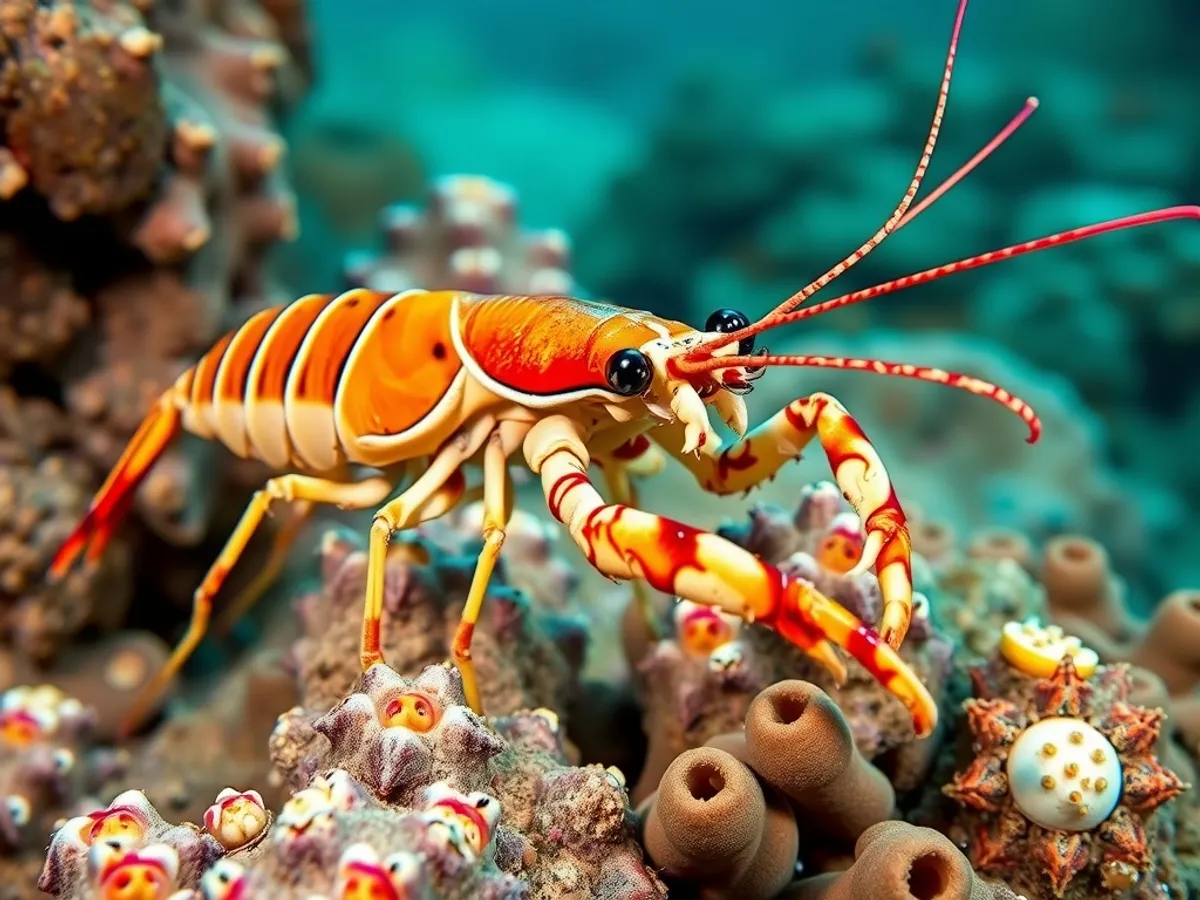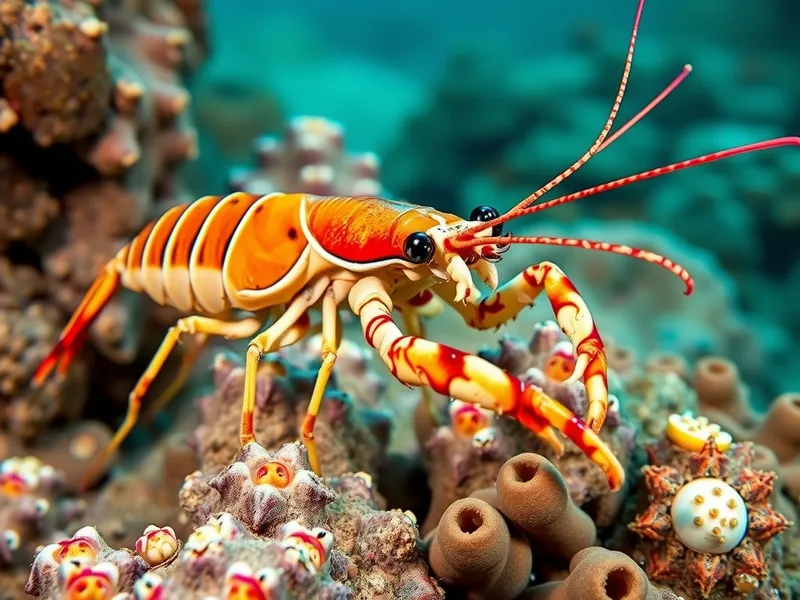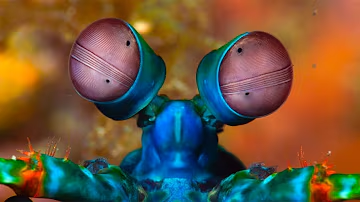
Stomatopod Mantis Shrimp
Odontodactylus scyllarus

Meet the Stomatopod Mantis Shrimp
The stomatopod mantis shrimp is a striking marine invertebrate known for its vibrant coloration and extraordinary hunting abilities. This species, often called the peacock mantis shrimp, is famous for its complex eyes that possess exceptional color vision, including ultraviolet and polarized light detection. It is renowned for its powerful raptorial appendages, which can strike prey with the speed and force of a bullet, easily smashing shells or stunning prey. Mantis shrimps inhabit burrows in coral reefs and sandy or muddy substrates in tropical and subtropical Indo-Pacific waters.
Classification
Invertebrate
Habitat
Coral reefs and rocky or sandy coastal substrates
Diet
Carnivore
Lifespan
6-20 years
Conservation
Least Concern
Weight
30-200 grams
📖Fascinating Facts
Incredible Vision
Mantis shrimps have trinocular vision in each eye and can detect polarized light and 12-16 color channels, compared to humans who have only three.
Lightning-fast Strike
Their club-like appendages accelerate faster than a bullet, reaching speeds up to 80 km/h (50 mph) and delivering impacts over 1,500 newtons.
Burrow Dwellers
Mantis shrimps create and defend burrows in the substrate, which serve as protection and as a base for ambushing prey.
📋Detailed Description
Odontodactylus scyllarus, commonly known as the peacock mantis shrimp, is a large and visually striking stomatopod crustacean, typically reaching lengths of 10–18 cm, with some individuals exceeding 20 cm. Its exoskeleton is vividly colored, displaying iridescent greens, blues, reds, and oranges, which serve both as camouflage among coral reefs and as a warning to potential predators. The species is renowned for its highly specialized raptorial appendages, known as 'smashers,' which can accelerate underwater at speeds exceeding 23 m/s and deliver blows with forces comparable to a .22 caliber bullet, capable of breaking hard-shelled prey such as snails, crabs, and mollusks. The mantis shrimp's eyes are among the most complex in the animal kingdom, possessing up to 16 types of photoreceptor cells (compared to three in humans), enabling detection of ultraviolet, visible, and polarized light. Each eye is independently movable and divided into three parts, allowing trinocular vision in each eye and exceptional depth perception. O. scyllarus is a benthic species, typically inhabiting U-shaped burrows in coral rubble, sandy substrates, or under rocks, which it excavates and maintains. It is primarily solitary and territorial, using its burrow as both a hunting base and refuge from predators. The species exhibits complex behaviors, including ritualized displays and aggressive encounters to defend territory. Reproduction involves elaborate courtship and, in some cases, monogamous pair bonds during the breeding season. Females brood eggs within the burrow, providing protection and aeration until hatching. The peacock mantis shrimp plays a significant ecological role as both predator and prey within reef communities.
💡 Did you know?
The mantis shrimp's strike is so fast that it creates cavitation bubbles, producing heat and light that can stun prey even if the shrimp's limb misses.
🔬Research & Sources
🎭Behavior & Social Structure
Peacock mantis shrimps are diurnal, emerging from their burrows primarily during daylight hours to hunt. They are ambush predators, relying on stealth and rapid strikes to capture prey, often targeting hard-shelled invertebrates. The 'smashing' appendages are used not only for hunting but also in intraspecific combat, where ritualized displays and controlled strikes establish dominance and territory boundaries. Social interactions are generally limited, as individuals are highly territorial and will aggressively defend their burrows against conspecifics. Communication includes visual signals, such as body posturing and color displays, as well as substrate drumming produced by striking the burrow walls. Daily routines involve periods of active foraging interspersed with time spent maintaining the burrow and grooming. When threatened, O. scyllarus retreats rapidly into its burrow and may use its appendages to block the entrance.
👶Reproduction & Life Cycle
O. scyllarus exhibits seasonal breeding, with peaks often coinciding with warmer months. Courtship involves complex tactile and visual displays, with males sometimes presenting food items to females. Mating is typically promiscuous, though temporary monogamous pairings have been observed during the brooding period. Females lay clutches of several hundred to over a thousand eggs, which are either carried in the female's maxillipeds or attached to the burrow wall. The incubation period lasts approximately 9–14 days, during which the female aerates and protects the eggs. After hatching, planktonic larvae (nauplii) are released into the water column, where they undergo several molts before settling to the benthos and developing juvenile characteristics. Parental care is primarily maternal and ceases after larval release.
🛡️Adaptations & Survival
Key adaptations of O. scyllarus include its raptorial appendages, which have evolved to deliver extremely rapid and forceful strikes, facilitated by a spring-loaded mechanism and specialized saddle-shaped exoskeletal structures that store and release energy. Its exoskeleton is reinforced at points of impact to withstand repeated high-force blows. The compound eyes are uniquely adapted for multispectral and polarized light detection, aiding in prey detection, navigation, and communication. The burrowing lifestyle provides protection from predators and environmental stressors. Behavioral adaptations include ritualized combat to minimize injury and complex visual signaling for communication. The species' coloration provides both camouflage and aposematic (warning) functions.
📚Research Sources
🎨Cultural Significance
The peacock mantis shrimp has gained attention in popular culture for its extraordinary vision and striking power, often featured in documentaries and science communication. In some Indo-Pacific cultures, mantis shrimps are harvested for food, though O. scyllarus is less commonly consumed due to its aggressive nature and vivid coloration. Its unique biology has inspired biomimetic research in materials science and robotics. The species is sometimes kept in public aquaria, where it is valued for its vibrant appearance and fascinating behavior.
🔬Recent Research & Discoveries
Recent research has focused on the biomechanics of the mantis shrimp's strike, revealing a complex system of energy storage and release that has influenced the design of advanced synthetic materials. Studies of their visual system have contributed to developments in optical sensor technology and polarized light imaging. Ongoing ecological research examines the species' role in reef ecosystems and its responses to environmental stressors. Genomic studies are beginning to elucidate the genetic basis of its unique adaptations, including exoskeletal reinforcement and photoreceptor diversity.
🎥Wildlife Videos

Mantis Shrimp Packs a Punch | Predator in Paradise
#NatGeoWILD #MantisShrimp #PredatorInParadise About National Geographic Wild: National Geographic Wild is a place for all ...
Nat Geo Animals

Mantis Shrimp vs Octopus | Ocean Fight Night
About National Geographic Wild: National Geographic Wild is a place for all things animals and for animal-lovers alike. Take a ...
Nat Geo Animals

Mantis Shrimp Punches Crab’s Arm Off | Deadly Australians Ep104
Fringing this vast island continent, the Australian coastline is a magnet for marine assassins of all shapes and sizes. Though they ...
Love Nature

Unbelievable Punches: The Deadly Power of the Mantis Shrimp
The mantis shrimp isn't just a tiny ocean predator—it's an underwater powerhouse with one of the most powerful punches in the ...
Kritter Pals

The Most Amazing Animal Eyes | The Peacock Mantis Shrimp | Love Nature
The peacock mantis shrimp is arguably the most spectacular animal to roam the earth. With complex "trinocular" vision and an ...
Love Nature

Do Mantis Shrimp Have The World's Best Eyes? | Animal Senses Ep103
Seeing the world is one of the most amazing animal adaptations. Different types of eyes give animals different types of vision, and ...
Love Nature
🌍Habitat Information
The Stomatopod Mantis Shrimp typically inhabits Coral reefs and rocky or sandy coastal substrates environments. Stomatopod Mantis Shrimps have adapted to their environments with specialized features and behaviors.
Primary Habitat:
Coral reefs and rocky or sandy coastal substrates
More detailed habitat information will be available soon.
🛡️Conservation Status
The Stomatopod Mantis Shrimp is currently classified as Least Concern. Conservation efforts are crucial for preserving this species for future generations.
Common Threats:
- 🏠Habitat loss and fragmentation
- 🌡️Climate change impacts
- 🎯Hunting and poaching
- 🏭Human-wildlife conflict
⚠️Threats & Conservation Challenges
While currently listed as Least Concern, O. scyllarus faces localized threats from habitat destruction, particularly coral reef degradation due to climate change, ocean acidification, and destructive fishing practices such as blast fishing. Collection for the aquarium trade also poses a minor risk in some regions. Pollution and sedimentation can reduce suitable habitat and prey availability. Despite these pressures, the species remains widespread and relatively resilient, though ongoing reef decline could impact long-term population stability.
🔬Scientific Classification
Scientific Name
Odontodactylus scyllarus
Classification Hierarchy
🔍 About Taxonomic Classification
Taxonomic classification is a hierarchical system used by scientists to classify and organize living organisms based on shared characteristics and evolutionary relationships.
The system moves from broad categories (Kingdom) to increasingly specific ones, with each animal's scientific name typically consisting of its Genus and species.
📝Community Notes
Share your observations and insights about the Stomatopod Mantis Shrimp with our community of wildlife enthusiasts.
Join Our Community
Sign in to share your observations and connect with fellow wildlife enthusiasts.
Sign In to ContributeNo community notes yet
Be the first to share your observations about the Stomatopod Mantis Shrimp!
Explore Stomatopod Mantis Shrimp
Select a tab above to learn more about this amazing animal.
📸Photo Gallery
No photos available for this animal yet.
🌟Discover More Wildlife
Continue your journey of discovery with more fascinating animals from our database
